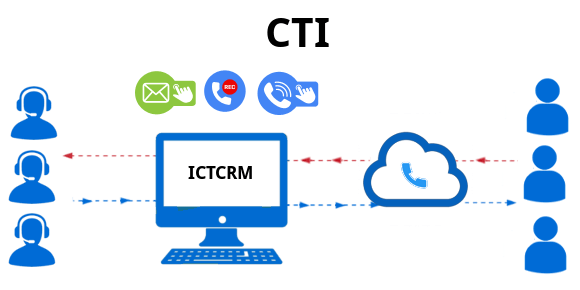Introduction:
In the ever-competitive business world, providing outstanding customer experiences is crucial for sustained success. Integrating customer relationship management (CRM) systems with unified communication (UC) technologies emerges as a pivotal factor in elevating customer experience. This integration empowers businesses to streamline communication channels, unify customer data, and deliver personalized interactions. This article delves into the profound influence of CRM integration with unified communication in bolstering customer experience.
1. Understanding CRM Integration with Unified Communication:
1.1 CRM Systems:
CRM systems are powerful software solutions designed to assist businesses in effectively managing customer interactions and relationships. These systems serve as centralized repositories for customer data, enabling businesses to monitor and analyze customer interactions. By leveraging this information, businesses can deliver tailored experiences that cater to individual preferences and behaviors, fostering stronger customer relationships.

1.2 Unified Communication:
Unified Communication (UC) refers to the integration of various communication channels, such as voice, video, messaging, and collaboration tools, into a single platform. It allows employees to communicate seamlessly and efficiently, regardless of the channel or device they use.

1.3 CRM Integration with Unified Communication:
CRM integration with unified communication involves combining CRM systems with UC technologies to enhance customer experience. It enables businesses to leverage customer data and communication channels in a unified manner, leading to improved customer interactions, streamlined processes, and better overall customer experience.
II. Key Benefits of CRM Integration with Unified Communication
2.1 Enhanced Customer Service:
CRM integration with UC empowers customer service representatives with real-time access to customer data and communication history. This allows them to provide personalized support, resolve issues faster, and offer a seamless experience across different channels. Improved customer service leads to higher customer satisfaction and loyalty.
2.2 Improved Collaboration and Efficiency:
By integrating CRM with UC, businesses can facilitate collaboration among team members. Relevant customer information can be shared instantly, enabling employees to work together more effectively and deliver a consistent customer experience. Unified communication tools also streamline internal communication, reducing response times and enhancing operational efficiency.
2.3 Personalized Marketing and Sales Efforts:
The integration of CRM with UC empowers businesses to access comprehensive customer insights. Through the analysis of communication data like call recordings, chat transcripts, and email interactions, companies can extract valuable information about customer preferences, pain points, and purchasing behavior. This data becomes a valuable resource for personalizing marketing campaigns, targeting specific customer segments, and customizing sales efforts to meet individual needs. By leveraging this integrated data, businesses can drive impactful and targeted strategies for enhanced customer engagement and satisfaction.
2.4 Omnichannel Customer Experience:
Today’s customers expect a seamless experience across multiple channels, including voice calls, emails, chat, and social media. CRM integration with UC enables businesses to achieve an omnichannel customer experience by synchronizing customer data and interactions across various communication channels. This consistency enhances customer satisfaction and reduces the likelihood of information gaps or disjointed experiences.
Implementing CRM integration with unified communication:
Integrating CRM systems with unified communication (UC) technologies can be a transformative step for businesses looking to enhance their customer experience. However, successful implementation requires careful planning and execution. Here are some key considerations and steps to follow when implementing CRM integration with unified communication:
Define Your Objectives and Goals
Start by clearly defining your objectives for CRM integration with unified communication. What specific outcomes do you hope to achieve? For example, you might aim to improve customer service, streamline communication processes, or enable personalized marketing efforts. Identifying these goals will help guide the implementation process and ensure that the integration aligns with your business objectives.
Assess Your Current Infrastructure
Evaluate your existing CRM system and communication infrastructure to identify any gaps or limitations. Consider the scalability, compatibility, and flexibility of your CRM and communication tools. Assess the strengths and weaknesses of your current systems to determine if any upgrades or changes are necessary before integration.
Select the Right CRM and UC Solutions
Selecting the right CRM and unified communication solutions is crucial for successful integration. Look for CRM systems and UC platforms that are compatible and offer robust integration capabilities. Consider factors such as ease of use, scalability, security, and vendor support. It is advisable to involve key stakeholders, including IT professionals, in the selection process to ensure that the chosen solutions meet the organization’s requirements.
Plan and Design the Integration Strategy
Create a comprehensive integration strategy that outlines the specific steps and timeline for implementation. Define the integration points between your CRM and UC systems, such as customer data synchronization, communication channel integration, and user access controls. Consider any customization or configuration requirements to align the integrated systems with your business processes.
Data Mapping and Migration
Ensure that your customer data is clean, organized, and compatible between the CRM and UC systems. Perform a thorough data mapping exercise to identify the fields and attributes that need to be synchronized. Develop a data migration plan that outlines how the existing data will be transferred or transformed to fit the integrated environment. Data integrity and security should be top priorities during this process.
Conclusion:
CRM integration with unified communication is a powerful strategy for enhancing the customer experience and driving business success. By combining CRM systems with UC technologies, businesses can streamline communication channels, consolidate customer data, and provide personalized experiences. The impact of CRM integration with unified communication is multi-faceted and yields several key benefits.
Firstly, integrating CRM with UC enables businesses to deliver enhanced customer service. Customer service representatives gain real-time access to customer data and communication history, allowing them to provide personalized support and resolve issues more efficiently. This leads to higher customer satisfaction and loyalty.
Leveraging Open Source in ICT
